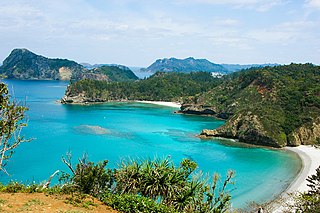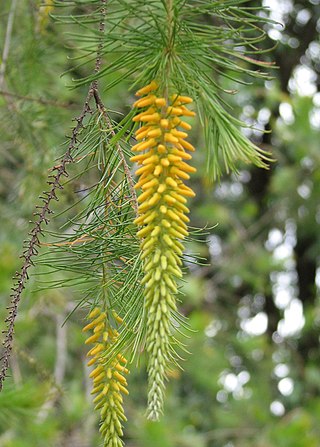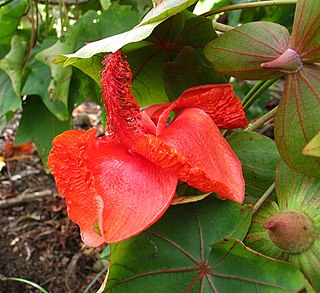
The Ogasawara subtropical moist forests is a terrestrial ecoregion which encompasses the Ogasawara Archipelago of Japan. The Ogasawara Archipelago lies in the Pacific Ocean south of Honshu, Japan's largest island, and north of the Marianas Islands. The ecoregion includes the Bonin Islands and Volcano Islands chains. The islands are volcanic in origin, and have never been linked to a continent. They are home to distinct plants and animals including many endemic species.

Persoonia pinifolia, commonly known as pine-leaved geebung or as mambara in the Cadigal language, is a plant in the family Proteaceae and is endemic to the Sydney region of New South Wales. It is an upright, woody shrub with soft, pine-like foliage and long, terminal racemes of small yellow flowers in late winter to summer.

Hibiscadelphus hualalaiensis is a species of flowering plant in the mallow family Malvaceae that is endemic to the Big Island of Hawaii.

Kokia drynarioides, commonly known as Hawaiian tree cotton, is a species of flowering plant in the mallow family, Malvaceae, that is endemic to the Big Island of Hawaii. It inhabits dry forests at elevations of 455–1,915 m (1,493–6,283 ft). Associated plants include ʻāheahea, ʻaʻaliʻi, hala pepe, wiliwili, uhiuhi, kōlea, ʻaiea, kuluʻī, ʻālaʻa, ʻohe kukuluāeʻo, māmane, and maua. It is threatened by habitat loss and competition with invasive species, such as fountain grass.

Eugenia koolauensis, commonly known as Koʻolau eugenia or nioi, is a species of flowering plant in the myrtle family, Myrtaceae. It is endemic to Hawaii, where it could previously be found on the islands of Molokaʻi and Oʻahu; today populations only exist on the latter. This is a federally listed endangered species of the United States.
Planchonella contermina is a species of plant in the family Sapotaceae. It is endemic to New Caledonia.
Planchonella kaalaensis is a species of plant in the family Sapotaceae. It is endemic to New Caledonia.
Pouteria villamilii is a species of plant in the family Sapotaceae. It is endemic to the Philippines. It is threatened by habitat loss. It was discovered in 1929.

Planchonella australis, also known by the synonym Pouteria australis, is a medium to tall rainforest tree of the family Sapotaceae native to Queensland and New South Wales, Australia. It is known by the common name black apple, wild plum, yellow buttonwood, black plum and yellow bulletwood.

Planchonella is a genus of flowering trees in the gutta-percha family, Sapotaceae. Named in honour of Jules Émile Planchon, it was described by Jean Baptiste Louis Pierre. It contains around 110 mainly tropical species, which range from Pakistan through Southeast Asia and New Guinea to northern and eastern Australia, New Zealand, and the Pacific Islands. The genus is included in the larger genus Pouteria by some authorities, hence species such as Planchonella australis are also known as Pouteria australis.

Planchonella eerwah is a rare species of Australian rainforest tree in the family Sapotaceae. Common names include shiny-leaved condoo, black plum and wild apple. It is endemic to south eastern Queensland, with a restricted distribution and regarded as endangered.

Planchonella obovata is a species of tree in the family Sapotaceae. The common name in Australia is the northern yellow boxwood. It occurs in many parts of south-east Asia, Micronesia, and on islands of the Indian Ocean, and has local common names there.

Planchonella cotinifolia is an Australian tree in the family Sapotaceae. The common names include small-leaved plum, yellow lemon and small-leaved coondoo. It occurs in the drier rainforests from the Richmond River, New South Wales to the Wenlock River in tropical Queensland.
Halodule pinifolia is a seagrass species in the genus Halodule. It is found in shallow sea waters.
Planchonella malaccensis is a tree in the family Sapotaceae. It is named after Malacca in Peninsular Malaysia.
Planchonella reticulata is a flowering plant in the sapodilla family, Sapotaceae. It is a shrub or tree endemic to east-central New Caledonia. The specific epithet refers to the reticulate venation on the leaves.

Stenanthera is a genus of flowering plants in the family Ericaceae. Most are low shrubs with leaves that are paler on the lower surface, tube-shaped flowers and with the fruit a drupe. There are three species, formerly included in the genus Astroloma.
Planchonella duclitan is a species of plant in the family Sapotaceae. A tree that may attain a height of 40 meters, presenting glossy leaves and orange fruit. It is common on Christmas Island, dominating up to 20% of the upper leaf canopy, as a tree to 30 meters, in established forest or around 40% in regenerating habitat where it may attain the maximum height.
Planchonella torricellensis is a tree in the family Sapotaceae. It is native to Maluku, the Lesser Sunda Islands New Guinea, Fiji, Niue, the Samoan Islands, Tonga, the Tuamotus, and Wallis and Futuna.











